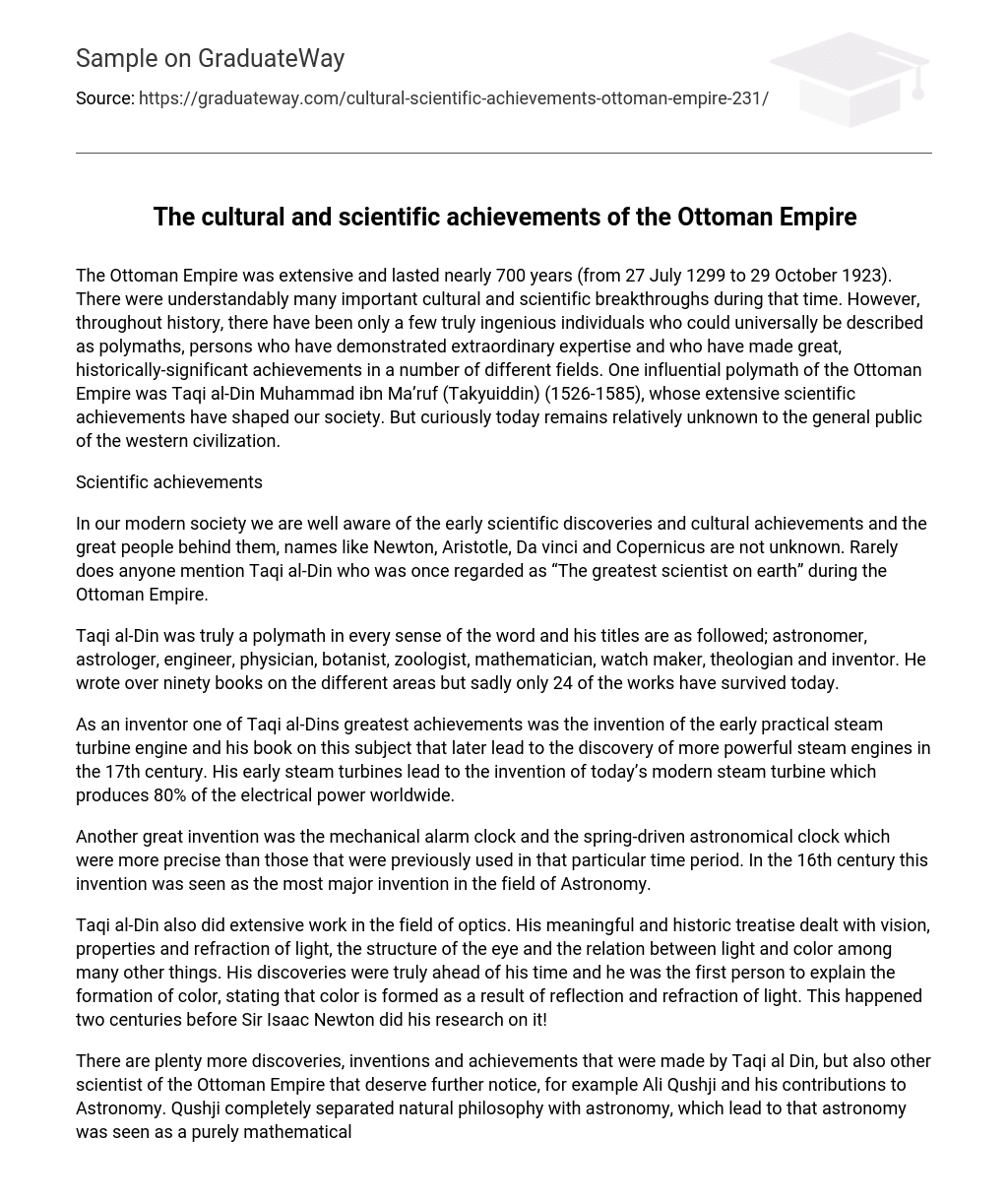The Ottoman Empire, which lasted for almost 700 years (from 27 July 1299 to 29 October 1923), made numerous important cultural and scientific advancements. However, only a few individuals throughout history can truly be considered as polymaths – those who possess exceptional expertise and have achieved significant accomplishments in multiple fields. One influential polymath of the Ottoman Empire was Taqi al-Din Muhammad ibn Ma’ruf (Takyuiddin) (1526-1585), whose extensive scientific achievements continue to shape our society. It is peculiar that he remains relatively unknown to the general public in Western civilization.
Scientific achievements
Although figures such as Newton, Aristotle, Da Vinci, and Copernicus are widely recognized for their scientific achievements and cultural contributions in our contemporary society, Taqi al-Din is frequently disregarded. Even though he was acclaimed as “The greatest scientist on earth” during the Ottoman Empire era, his legacy remains relatively obscure.
Taqi al-Din, a polymath, was skilled in astronomy, astrology, engineering, medicine, botany, zoology, mathematics, watchmaking, theology and invention. He authored more than ninety books encompassing these fields. However, only 24 of his works have endured to the present day.
Taqi al-Din, an inventor, played a crucial role in the development of early practical steam turbine engines. His groundbreaking book on this subject ultimately paved the way for more advanced steam engines in the 17th century. The groundwork he established with his initial steam turbines eventually led to the creation of the contemporary steam turbine, which currently generates 80% of global electrical power.
The mechanical alarm clock and spring-driven astronomical clock were revolutionary inventions, surpassing the previous timekeeping devices used during that era. During the 16th century, these inventions were regarded as the most significant advancements in the field of Astronomy.
Taqi al-Din, a renowned scholar, made significant contributions to optics. His remarkable treatise focused on various aspects such as vision, light’s properties and refraction, the eye’s structure, and the connection between light and color. His groundbreaking findings were exceptionally advanced, as he was the first to elucidate the formation of color through the reflection and refraction of light. Notably, this occurred two centuries prior to Sir Isaac Newton’s similar research.
Taqi al Din and other scientists of the Ottoman Empire made numerous discoveries, inventions, and achievements worth mentioning. For instance, Ali Qushji significantly contributed to Astronomy. Qushji distinguished natural philosophy from astronomy, resulting in the perception of astronomy as a fully mathematical science devoid of speculations. Additionally, he enhanced the planetary model and proposed an alternative model for Mercury.
Cultural achievements
During the Ottoman Empire, there was a period of great innovation and flourishing culture. Some argue that this time even rivaled the artistic and literary achievements of the European Renaissance. Suleiman the Magnificent’s prosperous reign encouraged the development of various forms of art including architecture, carpet weaving, poetry, ceramics, and more.
The Architecture during this period is particularly fascinating due to the innovative techniques and spatial solutions that were developed. These discoveries resulted in the construction of remarkable buildings that serve as excellent representations of the Ottoman Empire. One notable example is the Selim Mosque, designed by Sinan, the greatest architect of that time. Some of Sinan’s works are now regarded as masterpieces due to their simple yet clear design. Ottoman architecture stands out for not only incorporating Islamic artistic traditions but also merging them with European influences, resulting in something truly spectacular. While mosques and mausoleums are the defining monuments of Ottoman architecture, other significant structures were also erected. For instance, Sinan was responsible for designing 312 public buildings, including schools, palaces, hospitals, and public baths.
The Ottoman Empire’s literary accomplishments primarily revolved around Diwan poetry, a collection of poems. This highly ritualized and sacred art form adhered to Islamic forms and rules, even though it was produced by Turkish intellectuals. Diwan poetry predominantly consisted of lyrical compositions, such as gazels that explored illicit and unattainable love, as well as kasîdes that focused on a single central subject, typically serving theological and moral purposes.
During its golden age, the Ottoman Empire experienced a flourishing of art. Notable advancements were made in carpets, calligraphy, and ceramics. These exquisite creations portray the grandeur of Ottoman society and continue to captivate viewers today.
While the recognition of the Ottoman Empire’s scientific and cultural contributions is limited, it is important to acknowledge their significant influence on our contemporary society. By bridging the gap between the past and present, we can better understand our collective heritage and foster appreciation for diverse cultures in today’s world.





